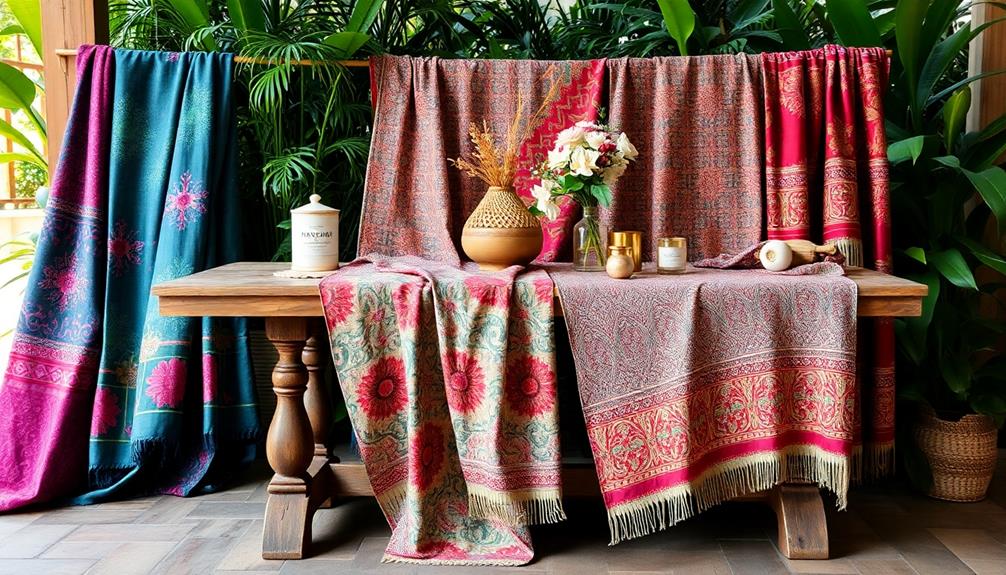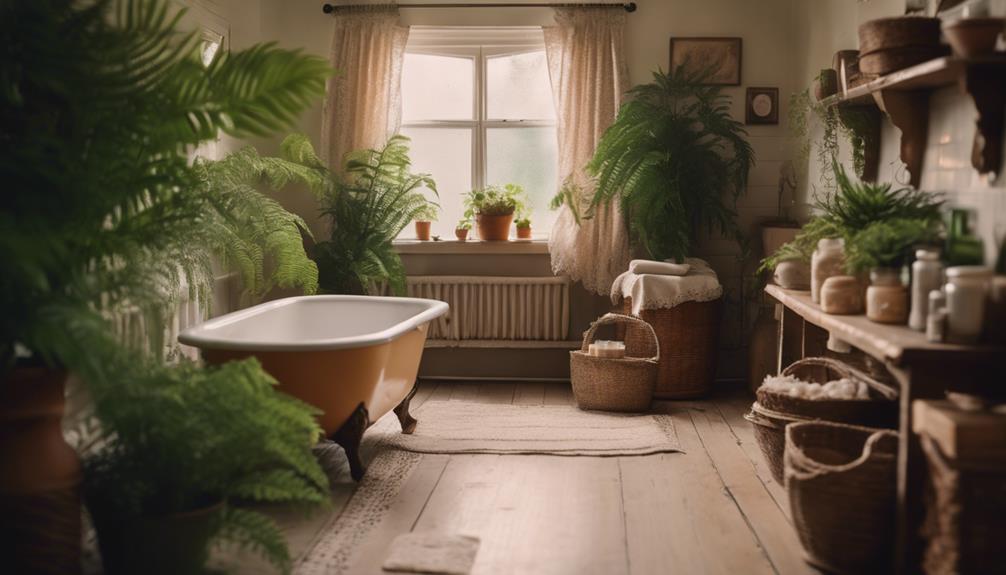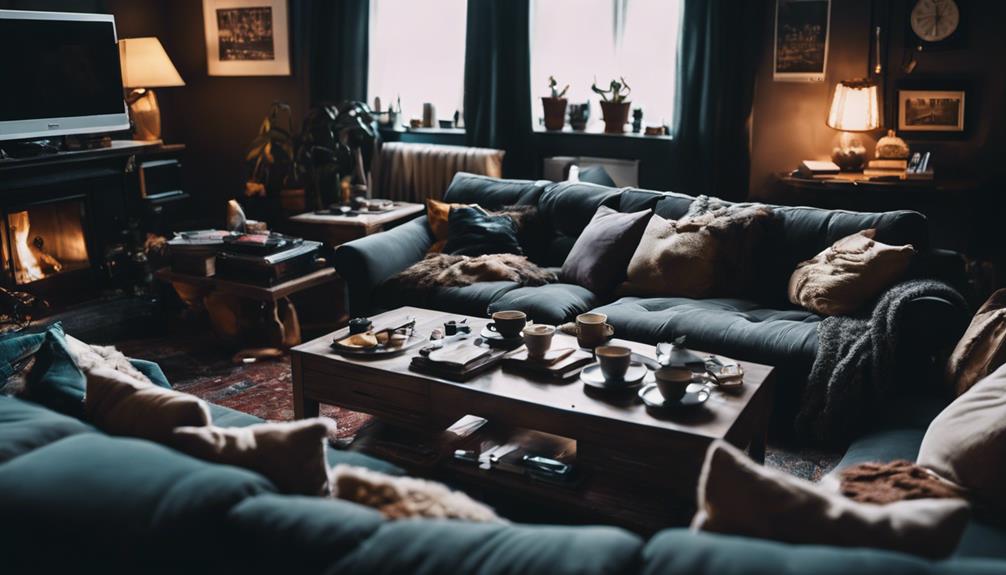Indonesian textiles, specifically batik, are a budget-friendly way to add a touch of luxury to your decor. The vibrant colors and intricate designs can instantly transform any space into a more luxurious atmosphere. Look for handmade pieces from local artisans or thrift shops for unique discoveries. Hand-drawn batik Tulis and stamped batik Cap offer different styles at accessible prices. Mixing these textiles with modern decor can elevate the overall look of your home. Supporting local artisans through your purchases promotes sustainable practices and craftsmanship. By making a few intentional choices, you can bring the charm of Indonesian textiles into your living space. Explore more ways to integrate these beautiful fabrics into your home decor.
Key Takeaways
- Incorporate vibrant batik textiles to add rich colors and intricate designs, enhancing the overall aesthetic of your home decor.
- Opt for handmade batik pieces, which are often more affordable than high-end designer options, while still showcasing craftsmanship.
- Mix traditional batik with contemporary styles for a modern yet culturally rich look that elevates your space.
- Shop at local artisan markets and thrift stores for unique batik fabrics that support sustainable practices and provide character.
- Engage in DIY projects using batik to create custom decor items, allowing for personal expression and budget-friendly enhancements.
The Allure of Indonesian Textiles

Indonesian textiles, especially batik, hold a unique charm that captivates anyone who appreciates artistry and culture. The intricate designs and vibrant colors of Indonesian batik not only enhance your home decor but also serve as a conversation starter.
These traditional textiles embody a rich cultural heritage, telling stories through their motifs, which historically reflected social statuses. Additionally, incorporating elements like traditional artistry can further enrich your decor and create a more immersive atmosphere. By incorporating batik into your living space, you can achieve a luxurious look without breaking the bank.
Handmade and available at various price points, these fabrics offer an affordable alternative to high-end designer options. Many modern designers are now embracing these traditional textiles, merging them with contemporary styles, making them more accessible for your home decor needs.
Moreover, purchasing Indonesian batik supports sustainable practices, ensuring fair wages for local artisans and preserving their craftsmanship. In a world increasingly concerned with fast fashion's environmental impact, choosing batik allows you to make a statement while contributing to a more ethical industry.
Understanding Batik Techniques

While exploring the world of batik, you'll discover that its beauty lies not just in the vibrant colors but in the intricate techniques used to create these stunning textiles. Batik is an Indonesian traditional art form that employs a wax resist dyeing technique, where melted wax protects certain areas of fabric from dye, allowing for intricate patterns.
The use of traditional fabrics like Batik and Ikat in Indonesian Decorative Pillows adds comfort and cultural heritage to your living space.
There are two primary methods for creating batik: Batik Tulis, which involves hand-drawing designs using a canting tool, and Batik Cap, which utilizes copper stamps for mass production. Each method showcases unique artistry and craftsmanship.
The dyeing process can involve multiple stages of waxing and dyeing, particularly in double-process batik. This technique enhances the complexity and richness of the final design, making each piece a work of art.
Traditional batik patterns, like Parang Rusak, often carry deep cultural significance and were historically reserved for nobility, with specific motifs representing various meanings.
Today, modern applications of batik in fashion have expanded its appeal, allowing you to appreciate its artistry while supporting local artisans and sustainable textile practices. Understanding these techniques deepens your appreciation for this beautiful Indonesian traditional craft.
Choosing the Right Fabrics
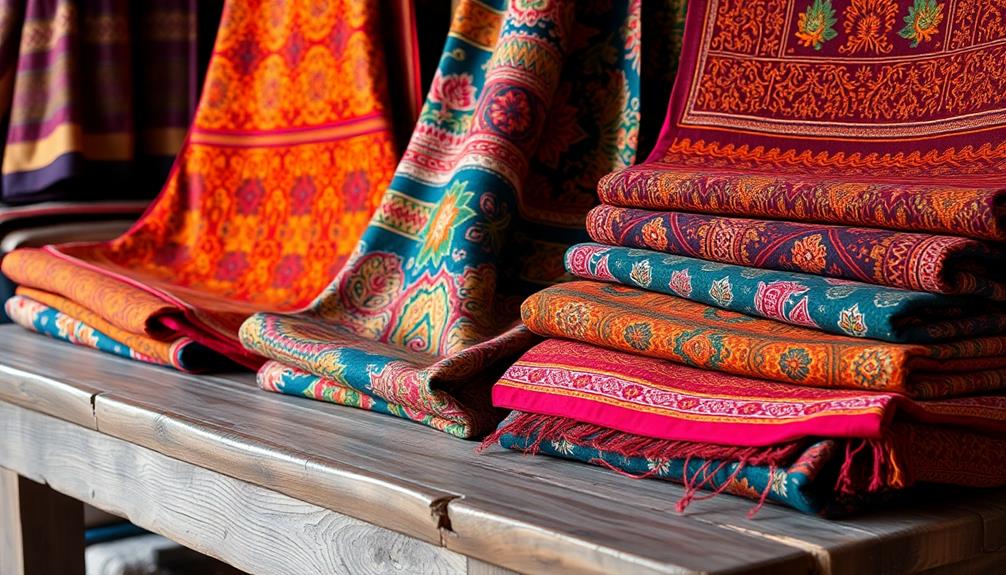
When choosing fabrics, you'll want to focus on options like batik, silk, and linen, which not only look luxurious but also fit your budget.
Indonesian textiles often feature intricate designs that tell stories and represent rich cultural heritage, making them a perfect addition to your decor.
Check local artisan markets and thrift stores for unique finds that can enhance your decor without breaking the bank.
Fabric Types Overview
Choosing the right fabrics can greatly impact both the look and feel of your space or wardrobe. When exploring Indonesian textiles, consider Batik, a traditional art form available in silk and cotton. Each piece showcases intricate designs, adding a touch of sophistication to any outfit or home decor.
Additionally, incorporating elements of Indonesian culture, such as Face Indonesian Decor Mask, can further enhance your decor aesthetic and appreciation for traditional craftsmanship.
If you appreciate craftsmanship, Batik Tulis is a must-try. This hand-drawn technique uses a canting tool, resulting in unique, high-quality pieces that reflect cultural heritage.
For a more budget-friendly option, Batik Cap employs stamped copper blocks to create traditional patterns, making it accessible without sacrificing style.
Don't overlook luxurious fabrics like linen and velvet. These materials exude a rich texture and timeless appeal, allowing you to achieve an upscale look on a budget.
Incorporating such fabrics not only enhances aesthetics but also supports sustainable practices and local artisans.
Budget-Friendly Sourcing Tips
Finding budget-friendly Indonesian textiles can be a rewarding experience that enhances your space or wardrobe without draining your wallet. Start by seeking authentic batik fabrics, which not only carry rich cultural history but also feature unique patterns that can elevate your decor.
Incorporating these textiles into your home can reflect the beauty of traditional Indonesian style home decor, promoting a relaxed atmosphere and harmony with nature. Purchasing directly from local artisans or markets supports sustainable practices and often means you'll score high-quality textiles at lower prices.
Don't overlook online platforms like LowPriceFabric.com, where you can find a wide selection of batik fabrics, often available at discounted rates during promotional sales. When choosing fabrics, opt for natural fibers like cotton and silk, which are commonly found in Indonesian textiles. They provide a luxurious feel at a fraction of the cost of synthetic alternatives.
Additionally, consider attending community workshops or textile fairs. These events let you discover unique, budget-friendly fabric options while engaging with the craftsmanship behind Indonesian textiles.
Affordable Sources for Textiles

Many budget-conscious shoppers discover that affordable sources for Indonesian textiles, particularly batik, are widely available. You don't need to break the bank to find high-quality options that add a luxurious touch to your space or wardrobe.
Incorporating traditional batik patterns can elevate your decor, making it feel rich and vibrant, especially when combined with Indonesian wedding decor ideas. Here are some great places to start your search:
- LowPriceFabric.com: This site offers a wide variety of batik fabrics in multiple colors, perfect for quilting and other projects at competitive prices.
- Local Fabric Stores: Many carry Indonesian textiles, allowing you to support artisans while browsing unique, culturally rich materials right in your community.
- Etsy: Explore handmade batik products from individual sellers, often priced more reasonably than mass-produced items.
Don't overlook thrift stores and second-hand shops, either. These can be treasure troves for vintage batik pieces, perfect for stylish home decor or fashion finds.
Plus, keep an eye out for special sales events at retailers like Michael Levine, where discounts on textiles make it an ideal time to snag high-quality batik without overspending.
With these options, you can easily incorporate stunning Indonesian textiles into your life on a budget. Whether you’re looking to add vibrant throw pillows, delicate wall hangings, or even table runners, there are many affordable ways to showcase the beauty of these fabrics. You can also explore online marketplaces or local artisan shops that offer rare Indonesian textiles for home, bringing unique craftsmanship and cultural heritage into your living space. By choosing these pieces, you’re not only enhancing your decor but also supporting traditional artisans from Indonesia.
Incorporating Textiles in Home Decor

Indonesian textiles, especially batik, can transform your home decor and create a luxurious atmosphere without straining your budget. By incorporating batik fabrics, you can infuse rich cultural patterns and vibrant colors into your spaces, enhancing visual interest and sophistication.
Additionally, using unique items like Indonesian decor masks can further elevate your decor by adding a striking focal point and a touch of cultural storytelling.
Consider using batik for DIY projects like pillow covers or wall hangings. This not only provides an upscale look but also supports local artisans and preserves traditional craftsmanship.
Layering batik with other textures, such as velvets or linens, adds depth to your decor, making your home feel more inviting.
Don't overlook window treatments; custom curtains or shades made from batik can elevate a room's aesthetic, making it appear polished and elegant.
To achieve a cohesive style, display batik textiles in a complementary color palette alongside other decor items. This approach unifies your home's look and contributes to a curated design without incurring significant expenses.
Crafting Your Own Batik Pieces
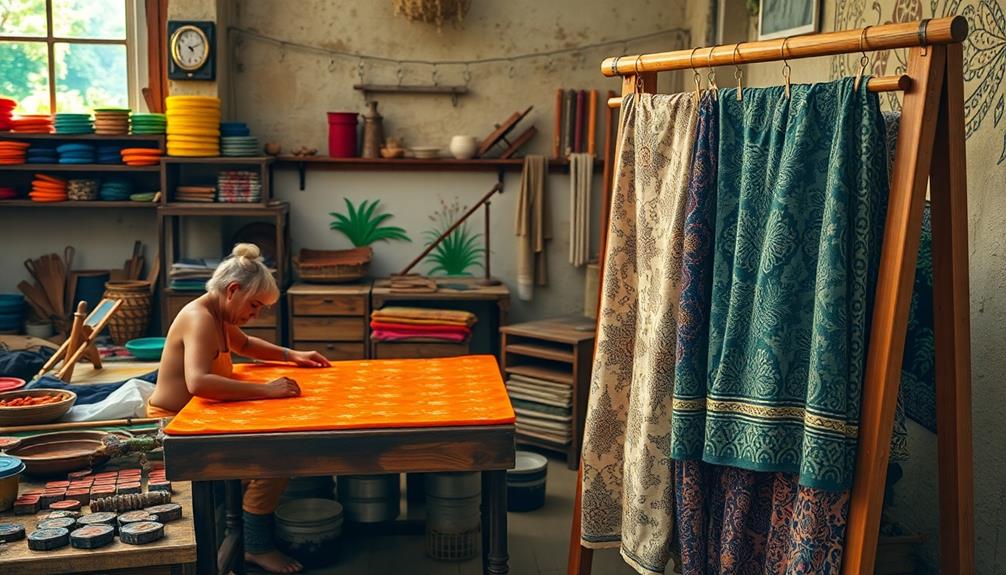
Ready to get creative? Crafting your own batik pieces lets you explore traditional techniques while choosing sustainable fabrics that reflect your style.
Incorporating intricate fabrics into your designs not only adds a touch of luxury but also honors the rich cultural heritage of Indonesia.
Whether you opt for hand-drawn designs or stamped patterns, DIY batik projects can transform your wardrobe and support artisanal methods.
Batik Techniques Overview
Creating your own batik pieces can be a rewarding experience that combines artistry and tradition.
You'll find that mastering various batik techniques allows you to express your creativity while respecting the rich heritage behind this textile art. Incorporating traditional motifs and patterns can add a unique touch to your design, reflecting the beauty of Balinese design characteristics.
Here's a quick overview of some techniques you can explore:
- Batik Tulis: Hand-draw intricate designs using a canting tool, giving your pieces a personal touch.
- Batik Cap: Utilize copper blocks to stamp patterns, speeding up production while still achieving beautiful results.
- Double-process batik: Apply multiple layers of wax and dye for complex patterns, although this method requires more time and effort.
The wax resist method, made from beeswax and paraffin, enables you to dye your fabric multiple times without losing the design's integrity.
Traditional motifs, like the Parang Rusak, carry cultural significance and can enhance your creations. Blending modern fashion with these timeless patterns not only showcases your unique style but also supports local artisans, ensuring these traditional techniques continue to thrive.
Immerse yourself in the world of batik, and let your imagination flourish!
Sustainable Fabric Options
A sustainable approach to crafting your own batik pieces not only enhances your wardrobe but also supports eco-friendly practices. Batik, a traditional Indonesian textile art, uses a wax resist technique that creates intricate designs, making it a luxurious fabric choice for your creations.
This art form, often practiced by local artisans, reflects the rich cultural heritage of Indonesia, similar to how traditional Indonesian housing showcases regional identity and craftsmanship. You can explore two primary batik techniques: Batik Tulis (hand-drawn) and Batik Cap (stamped). Batik Tulis is labor-intensive and often showcases more elaborate patterns, offering a unique touch to your pieces.
Sourcing batik fabrics directly from local artisans is a great way to support sustainable practices while ensuring that your creations reflect authentic cultural heritage. Plus, incorporating batik into your wardrobe can be budget-friendly. Many online retailers, like LowPriceFabric.com, offer a wide variety of affordable batik options perfect for quilting and crafting.
Creating your own batik pieces allows you to personalize your designs, tailoring patterns and colors to fit your unique style and home decor.
DIY Batik Projects
Transforming plain fabric into stunning batik pieces is a rewarding way to express your creativity. You can immerse yourself in DIY batik projects, using simple techniques that make it easy to produce beautiful designs.
With a mix of beeswax and paraffin, you can create a wax resist on affordable cotton fabrics, allowing vibrant colors to shine through after dyeing. Consider adding elements inspired by tropical contemporary architecture to your batik pieces to enhance their visual impact.
Consider these elements for your batik creations:
- Batik Tulis Techniques: Try using a canting tool to draw intricate patterns by hand, giving your pieces a unique touch.
- Traditional Patterns: Replicate traditional motifs like *Parang Rusak* to incorporate cultural significance into your home decor or wardrobe.
- Affordable Materials: Source inexpensive cotton fabric, making it accessible to craft without overspending.
Engaging in DIY batik not only enhances your space or style but also supports the preservation of this ancient Indonesian art form.
With patience and practice, you'll be able to craft your own masterpieces while celebrating a rich cultural heritage. So gather your materials and let your imagination run wild!
Sustainability in Textile Choices
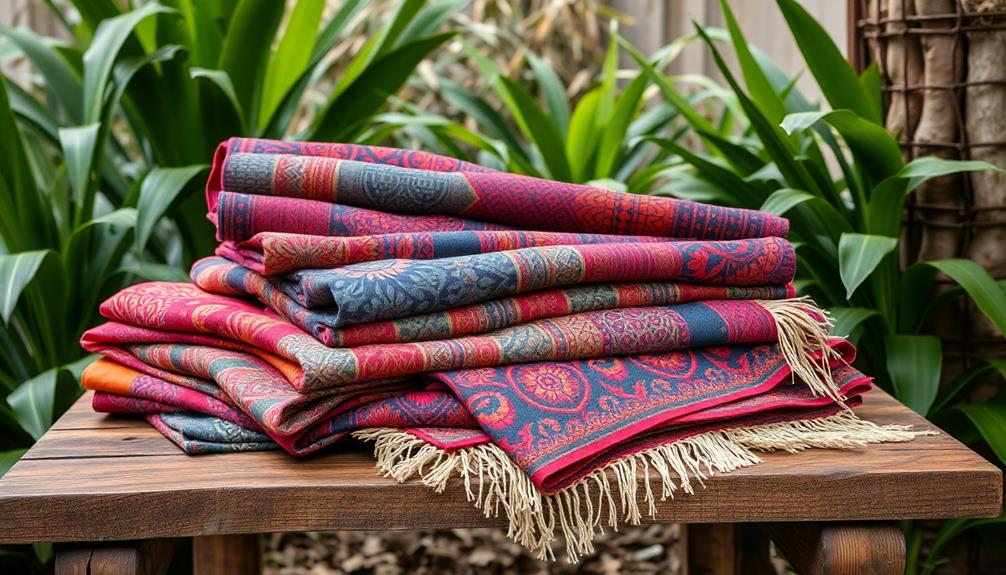
When it comes to making textile choices, many people are turning towards sustainable options that not only enhance their wardrobe but also support local artisans and preserve cultural heritage.
By choosing traditional Indonesian batik or participating in projects like IKAT/eCUT, you're directly contributing to eco-friendly practices and reducing the environmental impact of textile production.
Embracing the Slow Fashion movement is another way to elevate your style sustainably.
This approach encourages you to opt for low-impact materials, considerably lowering your carbon footprint compared to fast fashion alternatives.
Think about incorporating organic cotton and naturally dyed fabrics into your outfits.
These materials not only minimize harmful chemical use but also offer a luxurious aesthetic without the hefty environmental cost.
Elevating Spaces With Texture

To elevate your space, think about layering textures that complement Indonesian textiles.
Incorporating vintage fabrics and natural fiber accents can create a rich, inviting atmosphere.
This approach not only adds depth but also showcases the beauty of your decor while keeping it budget-friendly.
Layering Textures Effectively
Layering textures effectively can breathe new life into your space, creating an inviting atmosphere that's both sophisticated and tactile. By incorporating a variety of textures, you can draw the eye and invite touch, making your home feel luxurious without breaking the bank.
Consider these ideas to elevate your design:
- Combine rich velvet cushions with soft linen throws for a cozy yet elegant look.
- Pair smooth glass surfaces or polished wood with rougher elements like woven baskets or textured rugs to enhance visual appeal.
- Mix glossy textiles, such as shiny silk batik, with matte finishes like cotton to create dynamic contrast.
Layering different fabrics, like a batik throw with linen pillows, adds depth without overwhelming your design.
Don't underestimate the power of DIY projects, too! Create custom batik pillow covers or linen curtains to add personal flair and richness.
With these techniques, you'll transform your space into a luxe retreat that feels both inviting and stylish, all while sticking to your budget.
Embrace the art of layering textures, and watch your home come alive!
Incorporating Vintage Fabrics
Incorporating vintage fabrics into your decor not only elevates your space with unique textures but also adds a rich cultural narrative that modern materials often lack. Traditional Indonesian batik, for instance, offers intricate patterns that can transform an ordinary room into a visually striking environment.
These vintage textiles serve as statement pieces, drawing attention and sparking conversations.
By using vintage fabrics for DIY projects like throw pillows or wall hangings, you can express your personal style while keeping costs down. This customization not only makes your decor feel more authentic but also allows you to showcase the historical significance of the fabrics.
Plus, vintage textiles are often more durable than contemporary fast fashion materials, ensuring longevity in your home decor.
Sourcing these fabrics from local thrift shops or artisan markets supports sustainable practices and promotes the preservation of traditional craftsmanship.
By choosing vintage, you contribute to a more eco-friendly decor approach that respects heritage.
Natural Fiber Accents
Natural fiber accents can transform your home into a stylish haven, infusing it with warmth and texture that elevates any space.
By incorporating materials like cotton, linen, and silk from traditional Indonesian textiles, you can achieve a luxurious look without overspending. These fabrics not only add richness but also promote sustainability due to their biodegradable nature.
Consider these ideas to enhance your decor with natural fiber accents:
- Batik wall hangings: Use intricate batik fabrics as striking wall art, adding cultural significance while serving as a focal point.
- Layered textiles: Drape a batik throw over a linen sofa to create a cozy yet sophisticated atmosphere that invites relaxation.
- DIY projects: Craft cushion covers or table runners from natural fibers, allowing you to personalize your space and reflect your individual style.
Community Support for Local Artisans
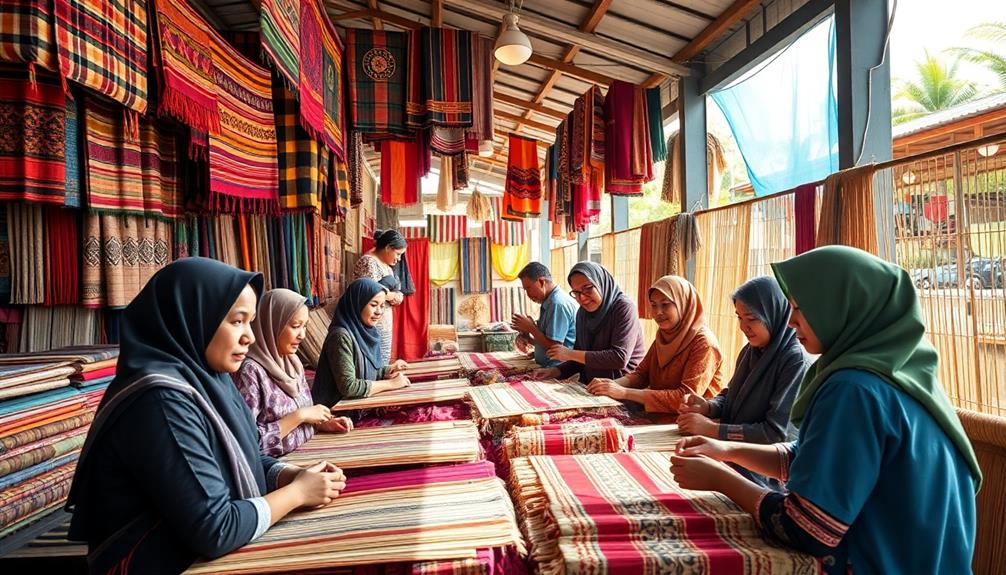
Over the years, supporting local artisans in Indonesia has become increasingly essential for preserving traditional craftsmanship and sustaining cultural heritage. When you purchase handmade batik textiles, you're not just getting a unique piece; you're also contributing to the livelihoods of artisans who rely on these crafts.
Initiatives like the IKAT/eCUT Project raise community awareness about sustainable textile production, highlighting the need for ethical consumption that benefits local creators.
Collaborating with Indonesian artists through programs like the Slow Fashion Lab encourages you to modify and repair garments. This fosters creativity while providing economic support to local craftspeople.
By engaging in community events and workshops, you can deepen your understanding of the significance of traditional textiles, reinforcing your role in supporting local artisans.
Your choices matter. By consciously opting for batik and other traditional textiles, you directly impact the local economy and help keep these vibrant art forms alive.
Celebrating Cultural Heritage in Design
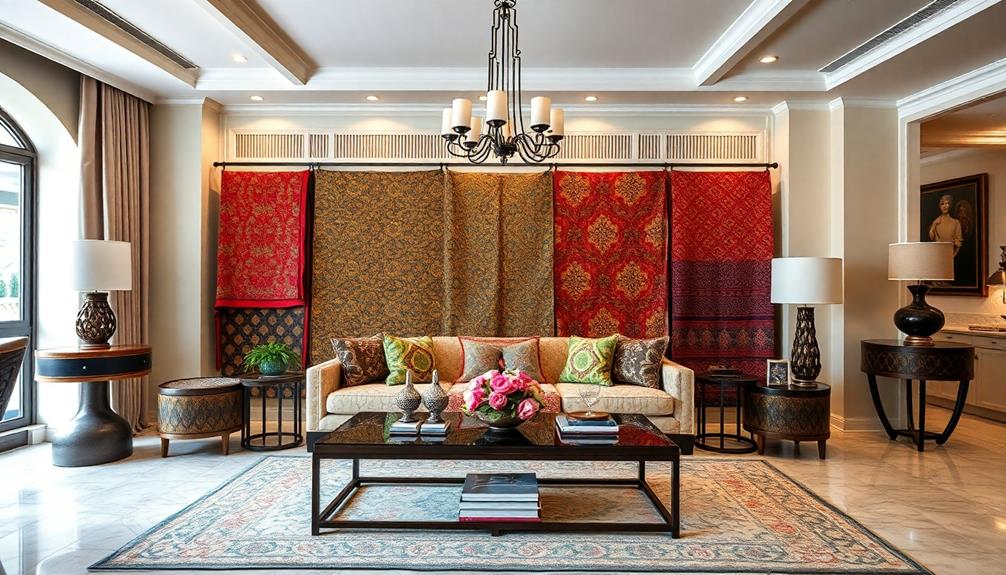
Embracing the vibrant world of Indonesian textiles, particularly batik, can truly transform your home design into a celebration of cultural heritage.
Batik's intricate, multi-layered designs showcase the remarkable craftsmanship of local artisans, allowing you to honor this ancient art form while enhancing your living space.
By incorporating batik into your decor, you not only elevate your aesthetic but also support the preservation of Indonesia's cultural legacy.
Consider these enchanting elements when integrating batik into your design:
- Vibrant Colors: Batik fabrics are rich with hues that can invigorate any space, making your home feel warm and inviting.
- Traditional Patterns: Each pattern tells a story, reflecting the diverse history and artistry of Indonesian culture that can spark conversations.
- Sustainable Choices: Many traditional fabrics use natural dyes and materials, promoting an eco-friendly approach to luxury decor.
Frequently Asked Questions
What Is an Indonesian Style of Textile?
You'll find that batik is a prominent Indonesian textile style, recognized for its intricate wax resist designs. Ikat, another style, features beautifully blurred patterns created by dyeing threads before weaving, showcasing Indonesia's rich cultural heritage.
How to Make Your Home Look Elegant on a Budget?
To make your home look elegant on a budget, focus on quality decor, incorporate rich textures, use strategic lighting, and select a few standout pieces that enhance your space without overwhelming it.
Conclusion
So, next time you're tempted to splurge on overpriced decor, remember: a little Indonesian textile can transform your space without draining your wallet. Why settle for bland, mass-produced items when you can wrap your home in vibrant culture? Embrace affordability while helping local artisans thrive. After all, who needs a yacht when you can have a Batik throw? Luxe looks don't have to come with a luxury price tag—just a dash of creativity and a hint of irony!
